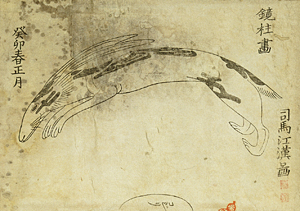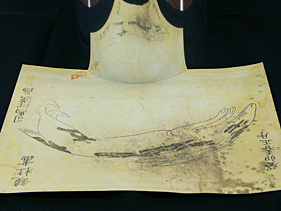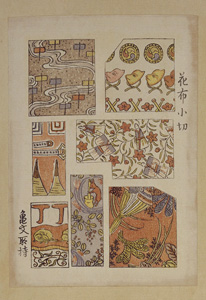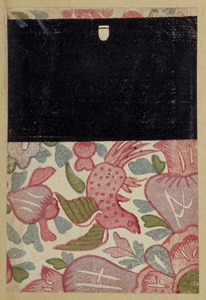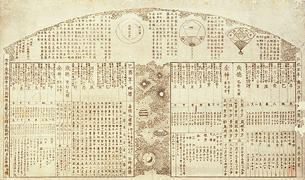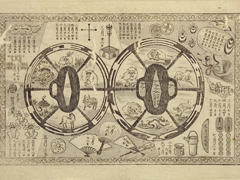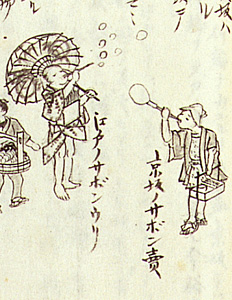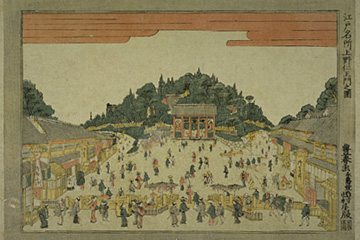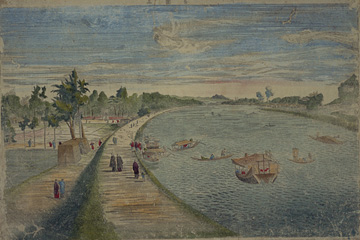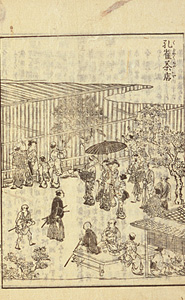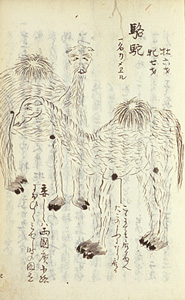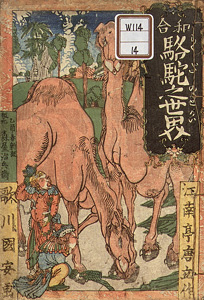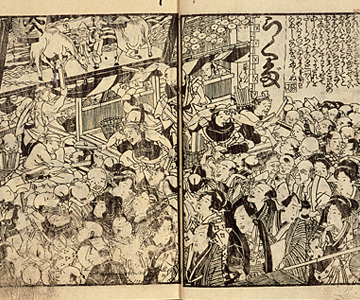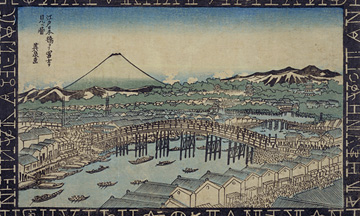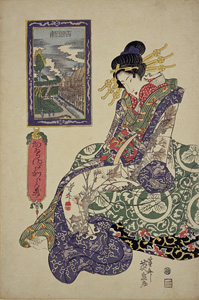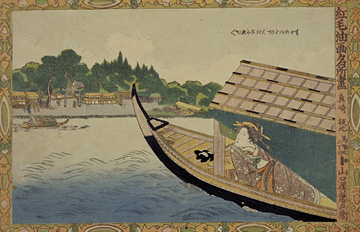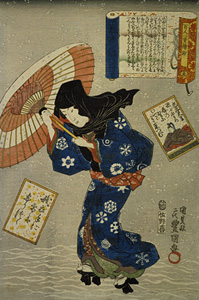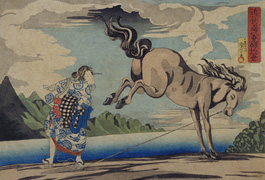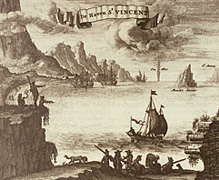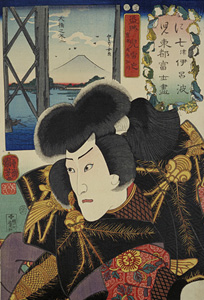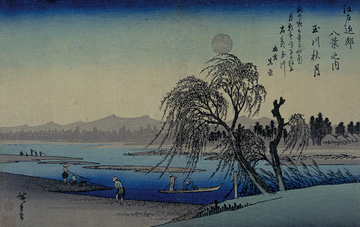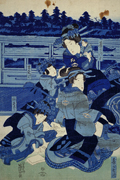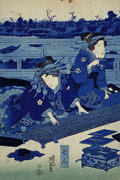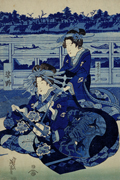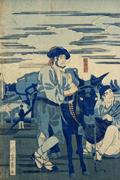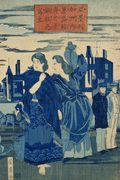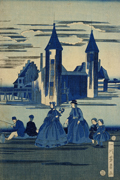Soap was brought to Japan from Spain and Portugal in the Azuchi-Momoyama period. It was not produced domestically until the Meiji era, and was a luxury good during the Edo period. In the summer traveling salesmen would sell sabondama (now shabondama (soap bubbles)). It states that, "Sabon powder was mixed in water, and then a thin tube was used to blow the liquid into air bubbles," but this "sabon powder" was not the expensive imported soap, but was a substitute substance made by aroid stem, etc.
Home | Part 2: View by Topics | 4. Receiving Knowledge from Overseas (2) Foreign Countries in Daily Life (2)
Part 2: View by Topics
4. Receiving Knowledge from Overseas
(2) Foreign Countries in Daily Life (2)
Exotic-style Calendars
The printing of calendars by the civil publishers was not allowed, but abbreviated calendars just showing the essentials on a single sheet were convenient, so they were often privately printed by merchants and sent to others during the seibo gift-giving season. The daisho reki calendar is a simple lunar calendar that just shows the long and short months (long month = 30 days, short month = 29 days) (→Details), and printing daisho reki became very popular in 1765 and thereafter. They were produced by many ukiyoe masters, and beautiful and resourceful examples still exist. If we look for foreign pastimes in this calendar, we find...
[Daishoreki] (anamorphosis) (Incl. in Tenmei egoyomi)
Illustrated by Shiba Kokan. 1 sheet. <841-217>
Anamoephosis was called kyochuga or saya-e. The picture looks strange at first glance, but when viewed in the reflection on a curved surface, such as that of a sword case (saya), it could be seen in its true proportions. This technique was learned from Europe and was popular during the mid Edo period. This image is from 1783 calendar, and the number of spots in the rabbits (1783 was the year of the rabbit among the twelve horary signs) , i.e. 2, 4, 5, 7, 9, and 11 show the long months. Belonged to the Kabutoyama Collection (Japanese).
[Daishoreki] (Kafu kogire) (Incl. in Egoyomi)
1 sheet. <WA33-1>
[Daishoreki] (Sarasa kamiire) (Incl. in Egoyomi)
1 sheet. <WA33-1>
These are two kinds of calico illustrated calendars. Calico was an imported luxury good, and even scraps were carefully saved. Kafu kogiri is designed looking like a calico scrap book. Sarasa kamiire is looking like a wallet made from calico. Inside the pattern, can be seen the numbers representing the short months.
[Ryakureki] (Incl. in Shumireki harimazecho)
1 sheet. <本別15-21>
[Hanjie koyomi] (Incl. in Egoyomi harimazecho)
1 sheet. <寄別13-64>
These are two kinds of calendars made by copperplate etching. Copperplate etching became increasingly popular since it was used by Shiba Kokan, and was used to print maps, illustrations in medical books, travel guides, and other applications. These abbreviated calendar is for the two years of 1848 and 1849, and is a strange calendar with a problem of mathematics written at the top and the six planets of Mercury, Mars, Venus, Jupiter, Saturn and Uranus drawn in the middle. The history of the creator, Morita Masaki, is unknown. The other is a pictorial puzzle calendar. On the guards of the long and short swords are respectively written the numbers for the long months and the short months, and the 'flying bird' (higan) in the long sword guard is the pun of 'higan' (equinox), and so it functions as a pictograph.
Foreign Entertainment Imported to Japan
Things from foreign countries were not only used as utilitarian goods, but also for entertainment.
Soap Bubbles
Morisada manko, v. 6 (Seigyo ge)
Ukie (Floating Pictures)
A 'direct viewing' type of peepshow, in which a picture was placed at one end of a dark box and then was peered at through a convex lens, was popular in the West from the mid 17th century, and came to Japan via China. By the mid 18th century, the 'reflection viewing' type where glasses were worn was invented in France and spread in Japan through trade with the Netherlands to obtain the equipment and copperplate eyeglass prints. Pictures drawn in perspective, their foreground are viewed like floating, so at the time they were popular attractions called ukie (floating pictures).
Edo meisho Ueno niomon no zu.
Illustrated by Utagawa Toyoharu. Edo: Eijudo Nishimuraya, n.d. 1 print: woodcut, col. <寄別2-1-1-6>
Mimeguri no kei.
Etched by Shiba Kokan. S.l.: s.n., 1783. 1 print: etching, hand col. <WA33-9>
Animal Attractions
Settsu meisho zue.
Imported animals were enjoyed by people as attractions. Kujaku chaya (peacock teahouse) was a tea house that attracted customers by keeping rare birds like the peacock, and had establishments in Edo, Osaka, Nagoya, and elsewhere during the Kansei period (1789-1801). This picture shows the kujaku chaya in Osaka (from Volume 2: Higashinari-gun). The shop is shown bustling with families.
Waga koromo.
By Kato Eibian. Ms. 18 v. <235-42>
This is an essay by Kato Genki (Eibian, b. 1763). In 1821, a camel was brought by a Dutch ship and became a huge boom. This book also uses illustrations to record this. It is said that this camel was exhibited in Ryogoku Hirokoji in Edo and too many people gathered to see it. As indicated by comments such as "The feeling of touching the camel was like touching a carpet," some people went to touch it.
Rakuda no sekai.
By Konantei Karatachi. Illustrated by Utagawa Kuniyasu. Edo: Moriya Jihei, 1825. 1 v. <W114-14>
This picture book picked up on the popularity of the camel. It shows a large crowd of people gathered to view the camel.
[Exotic-style Nishiki-e Prints]
Very colorful woodcut prints called nishiki-e could easily be obtained and enjoyed by the common people. Some of the nishiki-e prints reflecting social conditions show an air of exoticism.
Edo Nihonbashi yori Fuji o miru zu.
Illustrated by Keisai Eisen. Edo: Ezakiya Kichibei, n.d. 1 print: woodcut, col. <寄別2-9-1-10>
This is one of a series of nishiki-e prints by Keisai Eisen (1791-1848) ( See other works here). The frame incorporates the alphabet and the monogram of V.O.C. (acronym of the Dutch East-India Company). The shadows of the mountains and the clouds are also expressed in a Western style.
See other works here). The frame incorporates the alphabet and the monogram of V.O.C. (acronym of the Dutch East-India Company). The shadows of the mountains and the clouds are also expressed in a Western style.
Oiranda kagami. Yoshiwara tanbo.
Illustrated by Keisai Eisen. Edo: Shimizu, n.d. 1 print: woodcut, col. <寄別7-2-1-3>
This is one picture from a series. The title Oiranda kagami is a combination of 'Oranda' (Holland) and 'oiran' (courtesan) and the style of writing is shown in the Western cursive style. The frame picture at the top is in copperplate etching style.
Komo aburae meisho zukushi. Massaki.
Illustrated by Utagawa Kunisada. Edo: Yamaguchiya Tobei, n.d. 1 print: woodcut, col. <寄別7-1-1-3>
This is one picture from a nishiki-e print series by Utagawa Kunisada (1786-1864). The colorful frame is in Western style. The note at the upper right of the picture, "Motome ni yorite Kunisata egaku". (I drew this at the request) is written in hiragana (Japanese syllabary) horizontally, imitating Western writing style. A copperplate print style expression can be seen in the scene of the clouds and background.
Hyakunin isshu esho. 15. Koko Tenno.
Illustrated by Utagawa Kunisada aratame Toyokuni, Edo: Sanoya Kihei, n.d. 1 print: woodcut, col. <寄別2-3-2-1>
Stylized snowflake patterns of the snow crystals introduced in Sekka zusetsu (these are also called 'oimoyo' (oi patterns) because the creator, Doi Toshitsura, was an Oinokami) can also be seen in nishiki-e prints. This picture shows a woman wearing a kimono with snowflake patterns walking as snow falls, depicting the poem of Emperor Koko "I went into the spring meadow to gather young shoots for you as snowflakes alight on my sleeve" from the Ogura Hyakunin isshu (100 peems by 100 poets).
Omi no kuni no yufu Okane.
Illustrated by Utagawa Kuniyoshi. Edo: Yamaguchiya Tobei, n.d. 1 print: woodcut, col. <寄別7-1-1-5>
Nieuhof, J.: Gedenkwaerdige zee en lantreize door de voornaemste landschappen van West en Oostindien.
Amsterdam:Weduwe van I. van Meurs, 1682. 2 v. in 1. <WB29-67>
Okane was a powerful prostitute in Omi at the beginning of the Kamakura period. The story of her stepping on the reins of a galloping horse and calming it down also appears in Kokon chomonju. In this picture by Kuniyoshi, the horse and background are shown in Western style, which creates a wondrous atmosphere. Recent research has shown that the background was taken from an illustration in Volume 1 of Gedenkwaerdige zee en lantreize door de voornaemste landschappen van West en Oostindien by Joan Nieuhof (1618-1672), a Dutch traveler.
Nanatsu iroha Toto Fuji zukushi. Ni. Tozoku Jiraiya jitsuwa Ogata Hiroyuki.
Illustrated by Utagawa Kuniyoshi. Edo : Ebiya Rinnosuke, 1852. 1 print: woodcut, col. <寄別2-4-1-1>
Ichikawa Danjuro the 8th, an actor who played a brigand Jiraiya in a kabuki play, is shown here wearing a kimono bearing the image of the magnified mosquito introduced in Komo zatsuwa. This is quite novel.
Bero (Prussian Blue)
The synthetic pigment Prussian blue was discovered in Berlin in 1704. It was imported in Japan and replaced tsuyukusa blue, which bled and faded easily, and indigo, which is insoluble and difficult to prepare, so this pigment that can easily produce a range of blues spread rapidly after 1830. It was called 'bero' or 'herorin', and also gave birth to "aizuri" (blue print), which was used to create a feeling of distance in landscapes by feathering the blue sky or in pictures drawn only in shades of blue.
Edo kinko hakkei. Tamagawa shugetsu.
Illustrated by Utagawa Hiroshige. Edo: Sanoya Kihei, c.1833. 1 print: woodcut, col. <WA33-5>
This is a representative work of Utagawa Hiroshige (1797-1858). This is one scene out of an 8-part series and uses blue and gray tones to show the moon shining on the Tama River. In the foreground are drawn willows in black, the mountains in the distance are gray, and the sky is feathered with blue to create the feeling of a wide-open meadow.
[Karitaku no yujo]
Illustrated by Keisai Eisen. Edo: Tsutaya Kichizo, 1835. 1 print (3 sheets): woodcut, col. <寄別2-9-1-10>
Eisen was the first person in Japan to try blue print using Prussian blue. Only the lips of the prostitute are shown in red against a sky feathered from dark to light blue to enhance her charm. This print is an adaptation from the nishiki-e print titled Sugata Ebiya rojo no zu, and uses the technique of leaving the human figures unchanged while using blue print to change the background.
Amerika shunai Washinton fu no kei dohan no shasei.
Illustrated by Utagawa Yoshikazu. Edo: Maruya Jinpachi, 1861. 1 print (3 sheets): woodcut, col. <寄別7-4-2-3>
This is a blue print of a scene of Washington D.C., USA. The people in the foreground were based on an illustration ('Gossips at a well') appeared in the Illustrated London News, May 18, 1861 issue. Utagawa Yoshikazu (dates of birth and death unknown) was the disciple of Kuniyoshi, and was a representative Yokohama-e (Yokohama prints) artist. Yokohama-e mostly showed the customers of foreigners who came to Yokohama during the period from when the port was opened in 1859 until 1872.→ Go here for Kotokuniburi, a book of nishiki-e prints including Yokohamae.
Copyright © 2009 National Diet Library. Japan. All Rights Reserved

